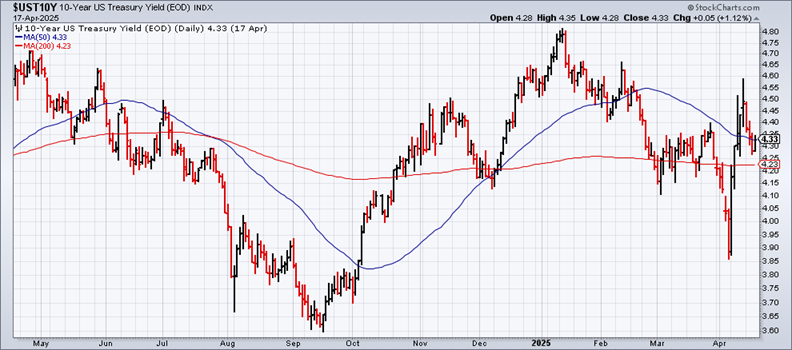Tyson Foods to close major Nebraska beef plant amid cattle shortage - WSJ
Financial markets are always pricing in uncertainty and risk, but the task has become dramatically more challenging in recent weeks after the US upended its longstanding trade policy. A repeat performance sentiment-roiling activity appears in store for the days ahead as investors wrestle with a series of high-stakes unknowns.
An early look at how the trade war is affecting expectations for the global economy is due tomorrow (Tues, Apr. 22), when the IMF publishes new projections for the world economy. IMF managing director Kristalina Georgieva offered a preview last week.
“Our new growth projections will include notable markdowns, but not recession,” she said on Thursday. “We will also see markups to the inflation forecasts for some countries. We will caution that protracted high uncertainty raises the risk of financial-market stress.”
Bloomberg Economics notes:
“The IMF’s projections tend to skew optimistic during potentially disruptive crises. In the four large crises we studied, the fund’s initial assessment of the immediate impact on global growth understated it by 0.5 percentage points. However much the IMF may downgrade the growth forecasts to start, history suggests the ultimate blow will be worse.”
Adding another dimension of risk to an already high-risk environment: President Trump’s comments last week that suggest he may try to fire Federal Reserve Chairman Powell.
“Markets are already on edge due to escalating geopolitical tensions, and now concerns are rising that Trump’s potential interference with the Fed could add another layer of uncertainty,” said Charu Chanana, chief investment strategist at Saxo in Singapore. “Any signs of political pressure on monetary policy could undermine the Fed’s independence and complicate the path ahead for interest rates just as investors are looking for stability amid global volatility.”
Second-order effects from the sharp change in US trade policy are another front that will influence markets. The latest development includes China’s announcement that it will retaliate against countries if governments engage in agreements with the US that threaten Beijing’s interests.
“Appeasement cannot bring peace, and compromise cannot earn one respect,” a Chinese Commerce Ministry spokesperson said. “China firmly opposes any party reaching a deal at the expense of China’s interests. If this happens, China will never accept it and will resolutely take countermeasures.”
A potential market-moving release this week is the initial estimate of survey data for the US economy in April. PMI survey data is expected to show that the manufacturing sector’s slight contraction in March deepened a bit in April, based on the consensus forecast via Econoday.com. The services sector, by contrast, is on track to continue growing, but at a substantially softer rate this month.
One question that markets will consider this week is whether President Trump’s sinking approval rating will force a change in policy. A new CNBC survey shows widespread dissatisfaction over his handling of tariffs, inflation and government spending:
The survey of 1,000 Americans across the country showed 44% approving of Trump’s handling of the presidency and 51% disapproving, slightly better than CNBC’s final reading when the president left office in 2020. On the economy, however, the survey showed Trump with 43% approval and 55% disapproval, the first time in any CNBC poll that he has been net negative on the economy while president.
Another line of analysis is that the bond market may persuade Trump to change tack on tariffs, assuming that yields rise. The multi-trillion-dollar US Treasury market is effectively a real-time poll, reflecting global sentiment. At stake is America’s ability to finance its large fiscal deficit, which relies in no small degree on foreign purchases of government bonds.
Foreigners hold roughly 30% of outstanding Treasuries. The risk is that offshore selling of US debt securities could sharply raise rates, making an already onerous expense burden for interest payments even worse, and creating a deeper shade of red for the US fiscal situation.
The benchmark US 10-year Treasury yield is probably the crucial market indicator to watch in the days ahead.
Last week, the rate ended at a relatively middling level – 4.33% — vs. recent history. Markets will be watching to see if a directional bias starts to emerge in the days ahead.
“Overall uncertainty has rarely been higher, but the US bond market and the dollar will be the ultimate scorecard that will decide the end game for this tariff policy,” said David Folkerts-Landau, group chief economist at Deutsche Bank (ETR:DBKGn) last week. “If both continue to weaken, the pressure will mount on the US administration to reverse a large degree of their recent actions. However, if things stabilize, their desire for huge change will keep them on an aggressive path.”
